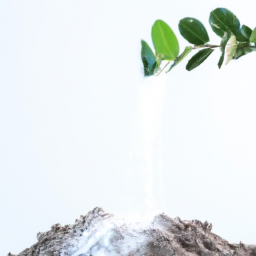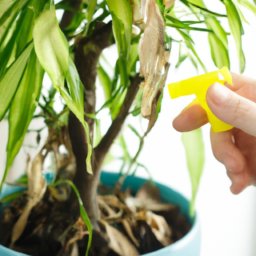
Hey there, fellow plant enthusiasts! Are you struggling with keeping your beloved greenery alive and thriving? Well, you’re in luck because today we’re diving headfirst into the world of overwatering. Yes, that’s right – we’re going to tackle the topic of dealing with overwatering: signs, solutions, and prevention. Whether you’re a seasoned plant parent or just starting out on your botanical journey, understanding the signs of overwatering, learning effective solutions, and implementing preventive measures can make all the difference in the health and happiness of your plants. So, let’s grab our watering cans and get ready to explore the wonderful world of managing water for our leafy friends!
Dealing with Overwatering: Signs, Solutions, and Prevention
Signs of Overwatering: How to Identify if Your Plants are Receiving Too Much Water
Have you ever wondered if you are overwatering your plants? It’s a common mistake that many gardeners make, but luckily, there are some telltale signs to look out for. In this guide, we will explore the signs of overwatering, provide solutions, and offer prevention tips to help you maintain healthy and thriving plants.
1. Wilting and Yellowing Leaves
One of the most obvious signs of overwatering is wilting and yellowing leaves. While it may seem counterintuitive, overwatering can actually suffocate the roots of your plants, leading to a lack of oxygen and nutrient uptake. This can result in leaves that appear weak, limp, and yellow. If you notice these symptoms, it’s a clear indication that your plants are receiving too much water.
Additionally, overwatering can lead to root rot, which further exacerbates the wilting and yellowing of leaves. Root rot occurs when the roots are constantly submerged in water, causing them to become waterlogged and prone to fungal infections. If you observe a foul smell or mushy roots when inspecting your plants, it’s a strong indication that overwatering is the culprit.
To address this issue, you should reduce the frequency of watering and allow the soil to dry out between waterings. This will give the roots a chance to recover and prevent further damage. It’s also important to ensure proper drainage by using well-draining soil and pots with drainage holes.
2. Mold or Fungus Growth
Another sign of overwatering is the growth of mold or fungus on the soil surface or plant leaves. Excess moisture creates a favorable environment for these microorganisms to thrive. If you notice a fuzzy white or green substance on the soil or a powdery coating on the leaves, it’s a clear indication that your plants are being overwatered.
To address this issue, you should improve air circulation around your plants by spacing them out properly and avoiding overcrowding. This will help reduce the humidity levels and discourage mold and fungus growth. Additionally, you can gently wipe off any visible mold or fungus from the leaves using a damp cloth. However, it’s crucial to adjust your watering routine to prevent further growth.
Furthermore, using a fungicide or neem oil spray can help control and prevent the spread of mold and fungus. Be sure to follow the instructions on the product label and apply it as directed.
3. Stunted Growth and Root Bound Plants
Overwatering can also lead to stunted growth and root bound plants. When the soil is constantly saturated, the roots struggle to access oxygen, resulting in poor growth and development. This can be observed through smaller leaves, shorter stems, and overall diminished plant size.
In addition, overwatering can cause the roots to become tightly packed and root bound. This occurs when the roots grow in a circular pattern, unable to expand and establish a healthy root system. If you notice roots circling around the bottom of the pot or protruding through drainage holes, it’s a clear indication of overwatering.
To address this issue, you should repot your plants into larger containers to allow for proper root development. Gently loosen the root ball and trim any circling roots before transplanting. Additionally, adjust your watering routine to ensure the soil is adequately moist but not waterlogged.
Preventing overwatering is key to maintaining healthy plants. Here are some prevention tips:
Prevention Tips:
1. Understand Your Plant’s Watering Needs: Different plants have different water requirements. Research the specific needs of your plants and adjust your watering routine accordingly. Factors such as plant type, size, and environmental conditions should be considered.
2. Check Soil Moisture: Before watering, always check the moisture level of the soil. Stick your finger about an inch deep into the soil – if it feels dry, it’s time to water. If it’s still moist, hold off on watering until it dries out.
3. Use Well-Draining Soil: Ensure that the soil you use is well-draining to prevent water from accumulating around the roots. Adding perlite or sand to the soil mix can improve drainage.
4. Provide Proper Drainage: Use pots with drainage holes to allow excess water to escape. If you have plants in decorative pots without drainage, be cautious not to overwater and consider using a liner with drainage holes.
5. Watering Techniques: Water your plants deeply but less frequently. This encourages the roots to grow deeper and become more resilient. Avoid shallow watering, as it promotes shallow root growth and increases the risk of overwatering.
6. Monitor Environmental Conditions: Factors like temperature, humidity, and sunlight can affect how quickly the soil dries out. Adjust your watering routine accordingly to accommodate changes in these conditions.
By being attentive to the signs of overwatering and implementing preventive measures, you can ensure that your plants receive the right amount of water for optimal growth and health. Remember, it’s better to underwater than to overwater, as most plants can tolerate short periods of drought, but recovering from overwatering damage can be much more challenging.

Solutions for Overwatering: Techniques to Correct and Restore Plants Affected by Excessive Watering
Overwatering can be detrimental to the health of your plants, causing root rot, nutrient deficiencies, and even death. However, if you’ve noticed the signs of overwatering and taken steps to address the issue, there are techniques you can use to correct and restore your plants. In this guide, we’ll explore some effective solutions to help your plants recover from excessive watering.
1. Assess the Damage
The first step in restoring plants affected by overwatering is to assess the extent of the damage. Look for signs such as yellowing leaves, wilting, and a foul odor. Gently remove the affected plants from their pots and examine the roots. Healthy roots should be firm and white, while overwatered roots may appear mushy, brown, or slimy.
If the damage is extensive and the roots are severely rotted, it may be difficult to save the plant. However, if the roots still have some healthy portions, there’s a chance for recovery.
Once you’ve assessed the damage, proceed with the following techniques to restore your plants:
2. Adjust Watering Practices
The most important step in preventing further damage and helping your plants recover is to adjust your watering practices. Overwatering is often caused by a lack of understanding of a plant’s specific needs. Research the watering requirements of each plant species you own and make necessary adjustments.
One effective technique is to switch to a well-draining soil mix. This allows excess water to flow out of the pot, preventing waterlogged conditions. Additionally, consider using a moisture meter to accurately gauge the moisture levels in the soil. This can help you determine when it’s time to water and when to hold back.
Remember, it’s better to underwater than to overwater. Most plants can tolerate a short period of drought, but consistent overwatering can lead to irreversible damage.
3. Repotting and Root Pruning
If the roots of your plant are still partially healthy, it may benefit from repotting and root pruning. Carefully remove the plant from its pot and gently shake off excess soil. Inspect the roots and trim away any mushy or rotten sections using clean and sterilized pruning shears.
Choose a new pot that is slightly larger than the previous one, ensuring it has drainage holes. Fill the pot with a well-draining soil mix, and position the plant in the center. Gradually add soil around the roots, firming it gently to eliminate air pockets. Water the plant sparingly after repotting, allowing the soil to dry out slightly between waterings.
Root pruning helps stimulate new root growth and encourages the plant to recover. However, it’s important to be cautious during this process, as excessive root pruning can further stress the plant.
4. Provide Adequate Light and Air Circulation
Proper lighting and air circulation are crucial for the recovery of overwatered plants. Ensure that your plants are placed in an area with adequate sunlight, as this helps dry out the soil and prevent further water retention. However, be cautious not to expose them to direct sunlight, as this can cause sunburn on stressed plants.
Additionally, providing good air circulation around your plants helps prevent the growth of mold and fungi, which thrive in damp conditions. Place a small fan near your plants to promote air movement, but avoid pointing it directly at them to prevent excessive drying.
Remember to regularly monitor your plants’ response to light and air circulation, as different species have varying requirements.
5. Adjust Fertilization and Nutrient Levels
Overwatering can leach essential nutrients from the soil, leading to nutrient deficiencies in your plants. Once your plants have started to recover, it’s important to adjust your fertilization practices to replenish these nutrients.
Choose a balanced fertilizer that contains essential macro and micronutrients. Follow the manufacturer’s instructions for application rates, and avoid over-fertilizing, as this can also stress the plants. Slow-release fertilizers can be particularly beneficial, as they provide a steady supply of nutrients over time.
Additionally, consider supplementing your plants with organic matter, such as compost or well-rotted manure. This can improve soil structure, enhance nutrient retention, and promote overall plant health.
6. Monitor and Maintain Proper Watering Techniques
After taking the necessary steps to restore your plants, it’s crucial to monitor and maintain proper watering techniques to prevent future overwatering. Remember to check the moisture levels in the soil regularly using a moisture meter or by feeling the soil with your finger.
Water your plants only when the top inch of soil feels dry, and ensure that excess water drains freely from the pot. Avoid leaving your plants sitting in standing water, as this can lead to root rot and other water-related issues.
Furthermore, be mindful of environmental factors that can affect watering needs, such as temperature, humidity, and seasonal changes. Adjust your watering frequency accordingly to provide optimal conditions for your plants.
By implementing these solutions and maintaining a careful balance of watering, lighting, and nutrient levels, you can successfully correct and restore plants affected by overwatering. Remember to be patient, as the recovery process may take time. With proper care, your plants will regain their health and thrive once again.

Dealing with Overwatering: Signs, Solutions, and Prevention
3. Prevention Tips: Best Practices to Avoid Overwatering and Maintain Healthy Plant Growth
When it comes to gardening, proper watering is crucial for the health and vitality of your plants. While underwatering can lead to dehydration and wilting, overwatering is equally harmful and can cause root rot, fungal diseases, and stunted growth. To ensure your plants thrive, it’s important to understand the signs of overwatering, implement effective solutions, and adopt prevention practices. In this guide, we will discuss some best practices to avoid overwatering and maintain healthy plant growth.
Signs of Overwatering
Recognizing the signs of overwatering is the first step in preventing damage to your plants. Here are some common indicators that your plants may be receiving too much water:
1. Wilting and Yellowing Leaves: Contrary to popular belief, wilting can also be a sign of overwatering. If the leaves appear yellow, mushy, or droopy, it’s likely that the roots are suffocating due to excessive moisture.
2. Fungus and Mold Growth: Overwatered soil creates a damp environment, promoting the growth of fungi and molds. Keep an eye out for white, fuzzy patches or slimy coatings on the soil surface.
3. Root Rot: When roots are constantly submerged in water, they can start to rot. Look for a foul odor emanating from the soil and black, mushy roots when examining the plant’s root system.
4. Slow or Stunted Growth: Overwatered plants often exhibit slower growth rates or fail to produce new leaves and flowers. The excess water prevents the roots from absorbing essential nutrients, leading to stunted growth.
Solutions for Overwatering
If you notice signs of overwatering in your plants, it’s crucial to take immediate action to prevent further damage. Here are some effective solutions:
1. Adjust Watering Frequency: Evaluate your watering schedule and reduce the frequency of watering. Most plants prefer slightly dry conditions between waterings, allowing their roots to breathe.
2. Improve Drainage: Ensure that your pots or garden beds have proper drainage holes. If water accumulates at the bottom, it’s a sign that the soil is not draining effectively. Consider adding organic matter or perlite to improve drainage.
3. Monitor Soil Moisture: Invest in a moisture meter or use the finger test to check the moisture level of the soil. Insert your finger about an inch deep into the soil; if it feels excessively wet, hold off on watering until it dries out.
4. Repotting: If your plants are suffering from severe overwatering, it may be necessary to repot them. Gently remove the plant from its current container, inspect the roots for any signs of rot, and replant it in fresh, well-draining soil.
Prevention Tips
Preventing overwatering is always better than dealing with its consequences. Here are some best practices to maintain healthy plant growth:
1. Understand Your Plant’s Watering Needs: Different plants have different water requirements. Research the specific needs of each plant in your garden and create a watering schedule accordingly. Factors like plant type, size, and environmental conditions should be taken into account.
2. Water at the Right Time: Watering your plants in the early morning or late afternoon allows them to absorb moisture before the heat of the day. Avoid watering during the hottest hours to minimize evaporation and water loss.
3. Use Mulch: Applying a layer of organic mulch around your plants helps retain moisture in the soil and prevents rapid evaporation. Mulch also acts as an insulator, keeping the roots cool during hot weather.
4. Observe Proper Watering Techniques: When watering, aim for the base of the plant rather than wetting the foliage. This reduces the risk of fungal diseases and ensures that water reaches the roots where it’s needed the most.
5. Consider the Weather: Adjust your watering schedule based on weather conditions. During rainy periods, you may need to reduce or skip watering altogether. On the other hand, during hot and dry spells, you may need to increase the frequency.
6. Regularly Inspect Your Plants: Keep a close eye on your plants and regularly inspect them for any signs of overwatering or underwatering. Early detection allows for prompt action and prevents further damage.
7. Use Self-Watering Systems: If you’re frequently away or struggle with maintaining a consistent watering schedule, consider using self-watering systems or drip irrigation. These systems provide water directly to the roots, reducing the risk of overwatering.
By following these prevention tips and implementing the suggested solutions, you can effectively avoid overwatering and ensure the healthy growth of your plants. Remember, maintaining a balance between proper hydration and avoiding excessive moisture is key to a thriving garden.
Key Takeaways
Overwatering is a common problem that many gardeners face, but it can have detrimental effects on the health of our plants. It’s important to know the signs of overwatering, as well as the solutions and prevention methods to keep our gardens thriving.
One of the most obvious signs of overwatering is wilting leaves. While this may seem counterintuitive, overwatered plants struggle to absorb oxygen, leading to a lack of nutrients and energy. Additionally, yellowing leaves and root rot are also indications that your plants are getting too much water. To solve this issue, it’s crucial to adjust your watering routine. Allow the soil to dry out between waterings and only water when the top inch feels dry to the touch. You can also improve drainage by adding organic matter to the soil or using raised beds. Prevention is key, so be mindful of the water requirements of different plants and adjust your watering schedule accordingly.
Top FAQs:
Q1: How can I tell if my plants are being overwatered?
A1: There are several signs to look out for if you suspect your plants are being overwatered. These include yellowing or wilting leaves, root rot, mold or fungus growth, a foul odor, and waterlogged soil. Additionally, if you notice that your plants are not thriving despite regular care, overwatering could be the culprit.
Q2: What should I do if I have overwatered my plants?
A2: If you have overwatered your plants, it’s important to take immediate action to prevent further damage. Start by stopping any additional watering and allowing the soil to dry out. You can gently remove the excess water by using a towel or sponge to soak it up. Ensure proper drainage for your plants by using pots with drainage holes or adding a layer of gravel at the bottom. Trim off any damaged or rotting roots and repot your plants in fresh, well-draining soil.
Q3: How can I prevent overwatering my plants in the future?
A3: Preventing overwatering requires establishing a proper watering routine and understanding the specific needs of your plants. Here are a few tips to help you prevent overwatering: 1) Check the moisture level of the soil before watering by sticking your finger about an inch deep into the soil. If it feels dry, it’s time to water. 2) Use well-draining soil and pots with drainage holes to ensure excess water can escape. 3) Adjust your watering frequency based on the season and the plant’s water requirements. 4) Consider using a moisture meter to accurately gauge the moisture level in the soil.
Q4: Can overwatering be fixed, or is it irreversible?
A4: While overwatering can cause significant damage to plants, it is often reversible if addressed promptly. By adjusting your watering habits, allowing the soil to dry out, and providing proper care, many plants can recover from overwatering. However, it’s important to note that severe cases of overwatering may lead to irreversible damage or plant death, especially if root rot has set in.
Q5: Are there any signs that indicate my plants need more water?
A5: Yes, there are signs that indicate your plants need more water. These signs include drooping or wilting leaves, dry soil that pulls away from the sides of the pot, and a lighter weight when you lift the pot. However, it’s crucial to strike a balance and avoid overwatering. Always check the moisture level of the soil before watering to ensure you provide the right amount of water for your plants’ specific needs.

Lisa Chen is a seasoned indoor gardening expert and the author of several bestselling books on the topic. With a background in horticulture and urban farming, Lisa is dedicated to helping urban dwellers embrace the joys of cultivating green spaces indoors. Her detailed guides and hands-on tips empower readers to transform their living spaces into thriving plant sanctuaries.


